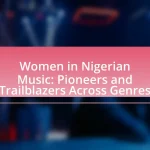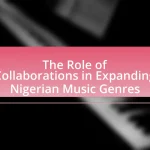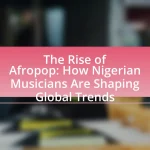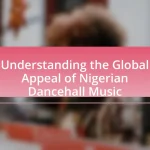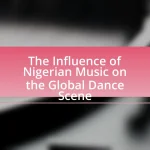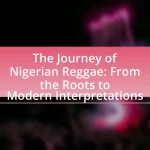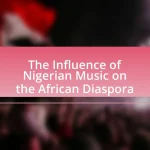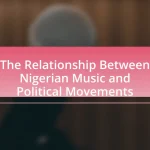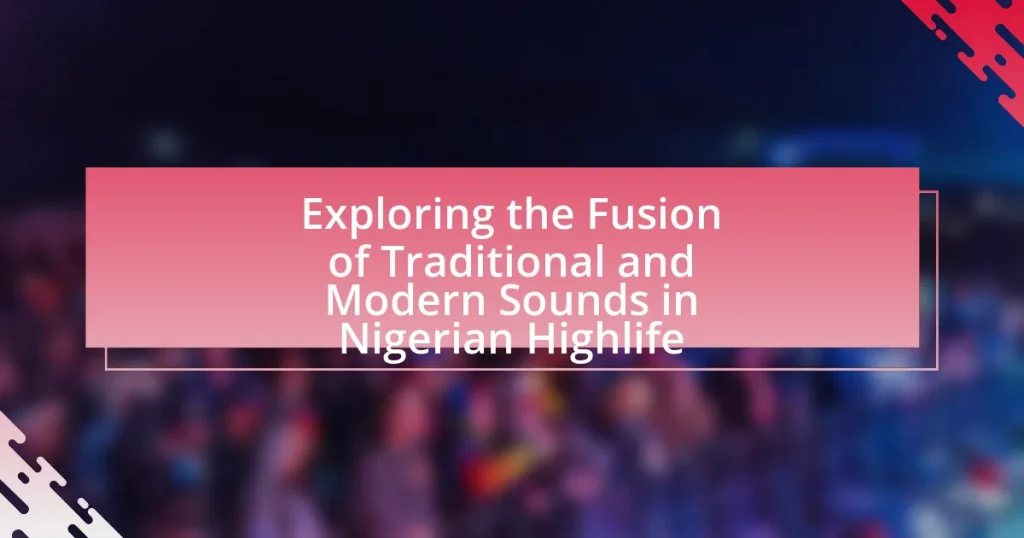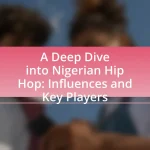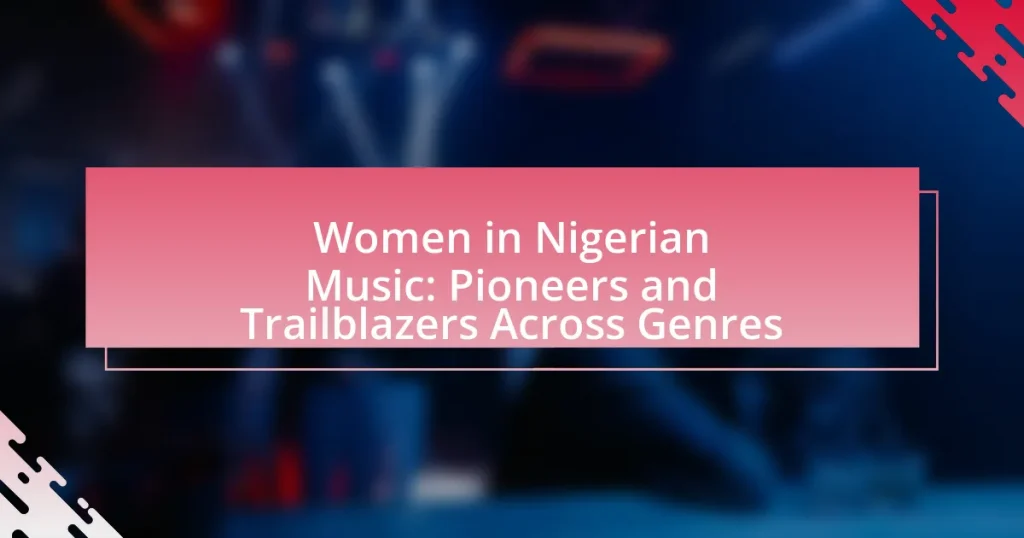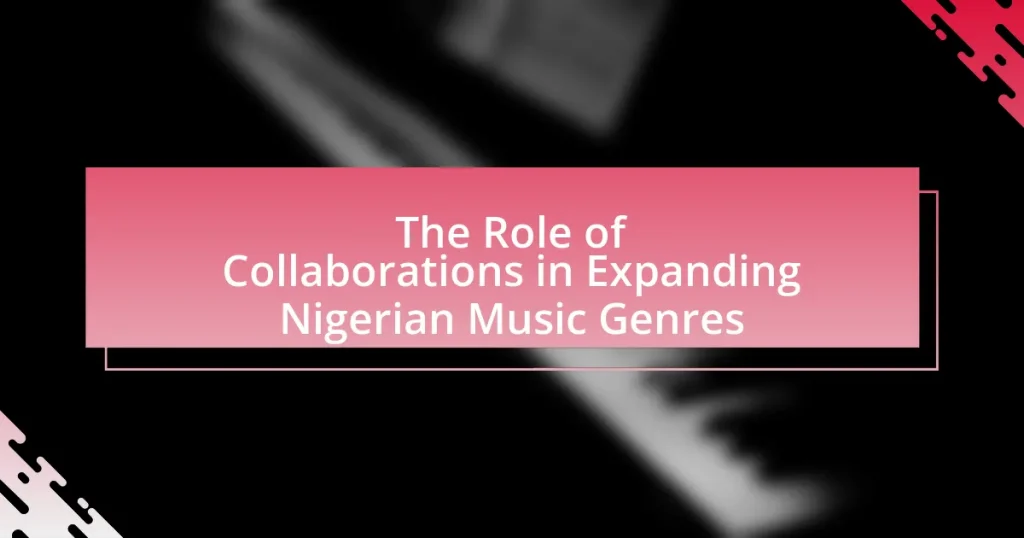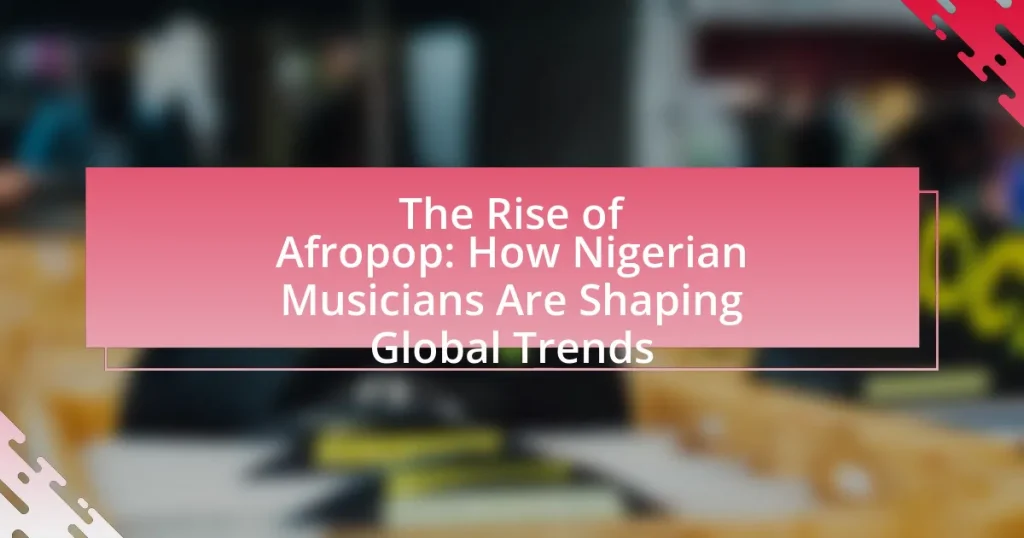The article explores the fusion of traditional and modern sounds in Nigerian Highlife, highlighting its evolution from early 20th-century roots to contemporary adaptations. It examines the integration of indigenous instruments and rhythms with modern genres such as jazz, funk, and electronic music, showcasing the contributions of prominent artists like E.T. Mensah and Flavour. Key characteristics of Highlife, including its cultural significance and the impact of technology and globalization on the genre, are discussed, along with the challenges it faces in maintaining its unique identity amidst changing musical trends. The article emphasizes the importance of this fusion in preserving cultural heritage while appealing to modern audiences.
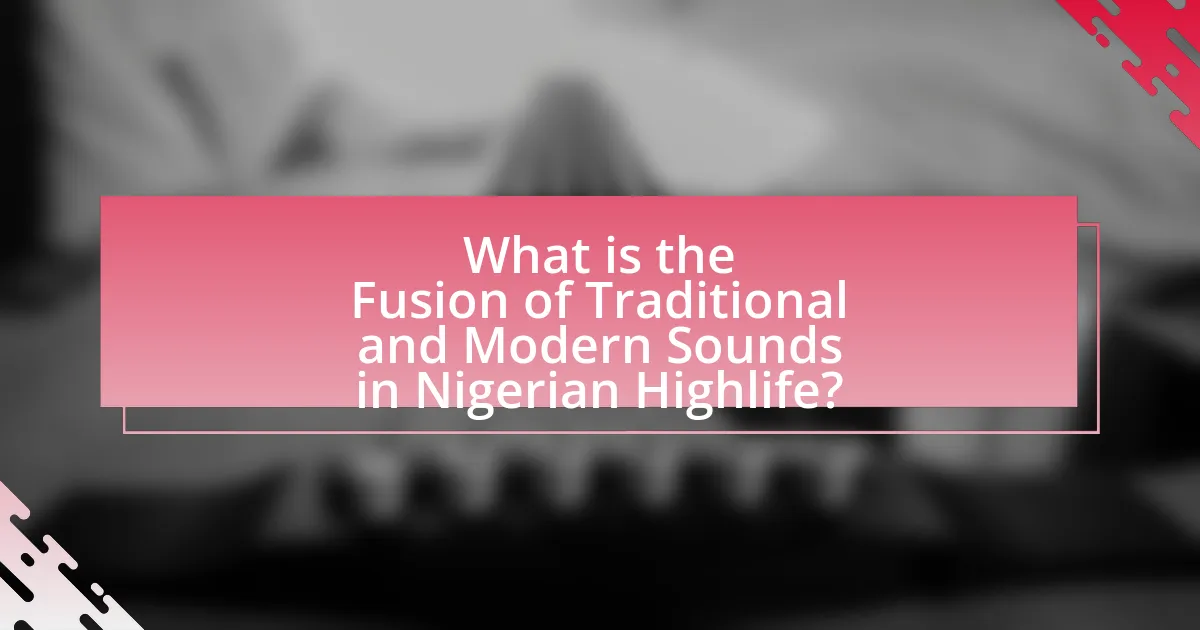
What is the Fusion of Traditional and Modern Sounds in Nigerian Highlife?
The fusion of traditional and modern sounds in Nigerian Highlife is characterized by the integration of indigenous musical elements with contemporary genres, creating a unique sound that reflects cultural evolution. Traditional Highlife incorporates instruments like the guitar, trumpet, and traditional drums, while modern influences introduce electronic instruments, jazz, and funk rhythms. This blend has led to a vibrant musical style that resonates with both local and global audiences, exemplified by artists such as Fela Kuti and E.T. Mensah, who have successfully merged these diverse musical traditions. The result is a dynamic genre that not only preserves cultural heritage but also adapts to modern musical trends, showcasing the versatility and richness of Nigerian Highlife.
How did Nigerian Highlife evolve over time?
Nigerian Highlife evolved through a blend of traditional African rhythms and Western musical influences, particularly during the early 20th century. Initially rooted in the Igbo and Efik cultures, Highlife incorporated indigenous instruments like the guitar, trumpet, and saxophone, reflecting the impact of colonialism and the introduction of jazz and swing music. By the 1950s and 1960s, Highlife gained popularity across West Africa, with artists like E.T. Mensah and Victor Olaiya further innovating the genre by integrating elements of funk and rock. This evolution continued into the 1970s and 1980s, as Highlife began to merge with other genres such as Afrobeat, leading to a more diverse sound that resonated with younger audiences. The genre’s adaptability and fusion of styles have allowed it to remain relevant in contemporary Nigerian music.
What are the historical roots of Nigerian Highlife music?
Nigerian Highlife music has its historical roots in the fusion of traditional African rhythms and Western musical influences, particularly from the colonial era. Originating in the early 20th century, Highlife emerged in coastal cities like Lagos and Accra, where local musicians began incorporating Western instruments such as the guitar and brass into their performances. This genre was heavily influenced by the arrival of European military bands and the spread of jazz and swing music, which inspired local artists to blend these styles with indigenous sounds. The use of traditional African instruments, such as the talking drum, alongside Western harmonies and melodies, created a unique sound that characterized Highlife music. This genre not only reflects the cultural exchange during colonial times but also serves as a representation of the social and political changes in Nigeria throughout the 20th century.
How have traditional instruments influenced modern Highlife?
Traditional instruments have significantly influenced modern Highlife by providing foundational rhythms and melodies that shape its sound. Instruments such as the xylophone, talking drum, and various string instruments have been integrated into contemporary Highlife music, creating a unique blend that retains cultural authenticity while appealing to modern audiences. For instance, the use of the talking drum allows for intricate communication and expression, which is a hallmark of Highlife’s musical style. Additionally, the incorporation of traditional percussion instruments enhances the rhythmic complexity of modern Highlife, making it distinctively vibrant and engaging. This fusion not only preserves the cultural heritage of Nigerian music but also enriches the evolving landscape of Highlife, ensuring its relevance in today’s musical scene.
What are the key characteristics of Nigerian Highlife?
Nigerian Highlife is characterized by its fusion of traditional African rhythms and Western musical elements, particularly jazz and swing. This genre typically features instruments such as the guitar, trumpet, and saxophone, alongside traditional percussion instruments like the talking drum. Highlife music often incorporates call-and-response vocal patterns, which are rooted in African musical traditions, and lyrics that reflect social and cultural themes relevant to Nigerian life. The genre emerged in the early 20th century, gaining popularity in the 1950s and 1960s, and has since evolved to include various sub-genres, showcasing its adaptability and enduring appeal in contemporary music.
How do traditional rhythms manifest in contemporary Highlife?
Traditional rhythms manifest in contemporary Highlife through the incorporation of indigenous percussion instruments and syncopated patterns that reflect the cultural heritage of West Africa. For instance, the use of instruments like the talking drum and shekere in modern Highlife music creates a rhythmic foundation that is deeply rooted in traditional African music. Additionally, contemporary Highlife often features polyrhythmic structures that echo the complex rhythms found in traditional folk songs, allowing for a seamless blend of old and new. This fusion not only preserves the essence of traditional music but also enhances the appeal of Highlife to modern audiences, demonstrating its evolution while maintaining cultural significance.
What modern elements are incorporated into Highlife music?
Highlife music incorporates modern elements such as electronic instrumentation, jazz influences, and contemporary rhythms. The integration of synthesizers and drum machines has transformed traditional Highlife sounds, allowing for a fusion with genres like hip-hop and R&B. Additionally, the use of digital production techniques has enabled artists to create more polished and diverse soundscapes, reflecting current musical trends. This evolution is evident in the works of contemporary Highlife musicians who blend traditional melodies with modern beats, appealing to a broader audience while maintaining cultural roots.
Why is the fusion of sounds significant in Nigerian Highlife?
The fusion of sounds is significant in Nigerian Highlife because it reflects the cultural diversity and historical influences of Nigeria. This genre combines traditional African rhythms and instruments, such as the talking drum and xylophone, with Western musical elements like jazz and swing, creating a unique sound that resonates with a wide audience. The blending of these musical styles not only showcases Nigeria’s rich heritage but also promotes social cohesion and cultural exchange, as seen in the popularity of Highlife across various ethnic groups and its evolution through different eras, particularly during the colonial and post-colonial periods.
How does this fusion reflect cultural identity?
The fusion of traditional and modern sounds in Nigerian Highlife reflects cultural identity by blending indigenous musical elements with contemporary influences, showcasing the dynamic nature of Nigerian culture. This integration allows for the preservation of traditional rhythms and instruments, such as the guitar and horns, while incorporating modern genres like jazz and hip-hop, which resonate with younger audiences. The result is a vibrant musical expression that not only honors Nigeria’s rich heritage but also adapts to global trends, illustrating the country’s ability to evolve while maintaining its cultural roots. This adaptability is evident in the works of artists like E.T. Mensah and contemporary musicians who continue to innovate within the Highlife genre, reinforcing the significance of cultural identity in a globalized world.
What impact does it have on the music industry in Nigeria?
The fusion of traditional and modern sounds in Nigerian Highlife significantly revitalizes the music industry by attracting a diverse audience and fostering innovation. This blending of genres enhances the appeal of Highlife, making it relevant to younger generations while preserving cultural heritage. For instance, artists like Flavour and Wizkid incorporate contemporary elements into traditional Highlife, resulting in increased streaming numbers and concert attendance, which are crucial for the industry’s economic growth. According to the International Federation of the Phonographic Industry (IFPI), Nigeria’s music market grew by 25% in 2020, largely driven by such innovative fusions.
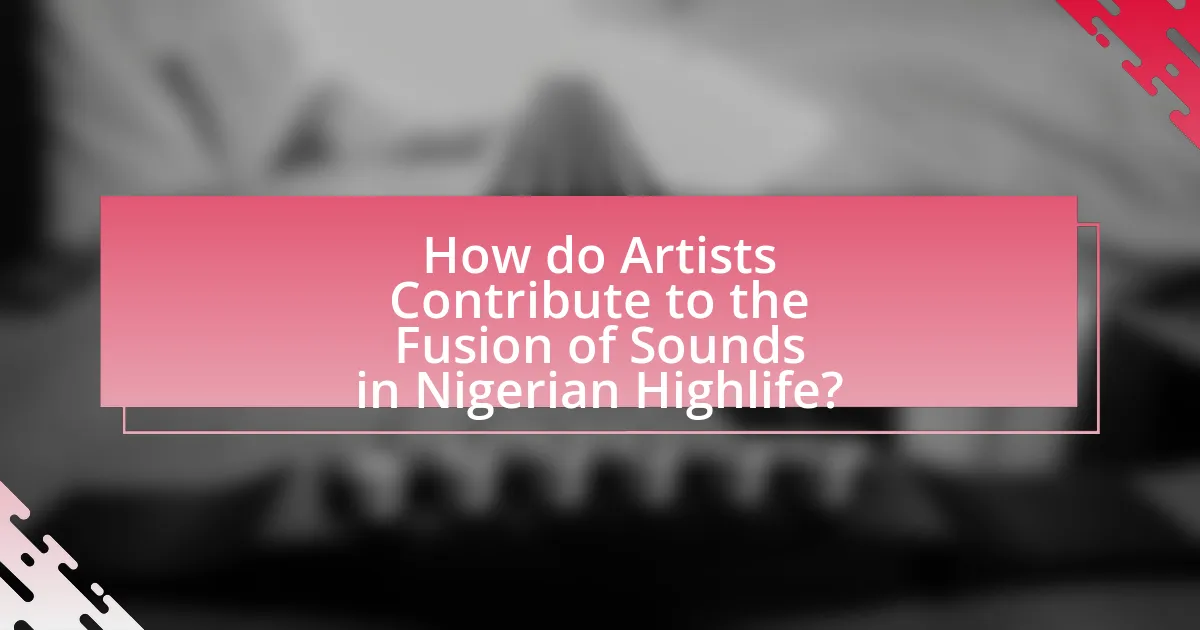
How do Artists Contribute to the Fusion of Sounds in Nigerian Highlife?
Artists contribute to the fusion of sounds in Nigerian Highlife by blending traditional African rhythms and instruments with contemporary musical styles and technologies. This integration is evident in the use of electric guitars, brass sections, and synthesizers alongside traditional instruments like the talking drum and shekere. Notable artists such as E.T. Mensah and Victor Uwaifo have historically incorporated elements from jazz, funk, and highlife, creating a unique sound that resonates with diverse audiences. The evolution of Highlife music reflects the socio-cultural changes in Nigeria, as artists adapt their music to include influences from global genres while maintaining a connection to their roots. This dynamic interplay of sounds has solidified Highlife’s status as a vibrant and evolving genre within the Nigerian music landscape.
Who are the prominent artists in the Nigerian Highlife scene?
Prominent artists in the Nigerian Highlife scene include Victor Uwaifo, who is known for his innovative blend of traditional Highlife with modern sounds, and Chief Stephen Osita Osadebe, recognized for his influential contributions to the genre. Additionally, other notable figures include Oliver De Coque, celebrated for his unique guitar style and energetic performances, and E.T. Mensah, who played a significant role in popularizing Highlife music across West Africa. These artists have shaped the genre through their distinctive styles and have left a lasting impact on the evolution of Highlife music in Nigeria.
What roles do these artists play in blending traditional and modern sounds?
Artists in Nigerian Highlife play a crucial role in blending traditional and modern sounds by incorporating indigenous musical elements with contemporary genres. They achieve this fusion by using traditional instruments, such as the guitar and percussion, alongside modern production techniques and electronic sounds. For instance, artists like E.T. Mensah and contemporary musicians like Flavour have successfully integrated highlife rhythms with Afrobeat and hip-hop, creating a unique sound that resonates with diverse audiences. This blending not only preserves cultural heritage but also makes traditional music accessible to younger generations, thereby ensuring its evolution and relevance in today’s music scene.
How do collaborations enhance the fusion in Highlife music?
Collaborations enhance the fusion in Highlife music by integrating diverse musical styles and cultural influences, which broadens the genre’s appeal and innovation. When artists from different backgrounds collaborate, they bring unique elements such as instrumentation, rhythms, and vocal techniques, enriching the traditional Highlife sound. For instance, collaborations between Highlife musicians and contemporary genres like hip-hop or jazz have resulted in innovative tracks that resonate with a wider audience, showcasing the adaptability of Highlife. This blending of styles not only preserves the essence of Highlife but also propels it into modern musical landscapes, making it relevant to new generations.
What techniques do artists use to create this fusion?
Artists create a fusion of traditional and modern sounds in Nigerian Highlife by employing techniques such as blending indigenous instruments with contemporary music technology. For instance, musicians often incorporate traditional instruments like the guitar, trumpet, and percussion alongside electronic keyboards and synthesizers, which allows for a rich sound palette. Additionally, artists utilize rhythmic patterns and melodic structures from traditional Highlife while integrating modern genres like jazz, funk, and hip-hop, creating a hybrid style that appeals to diverse audiences. This approach not only preserves cultural heritage but also innovates the genre, making it relevant in today’s music scene.
How do they incorporate technology in their music production?
Nigerian Highlife musicians incorporate technology in their music production by utilizing digital audio workstations (DAWs), synthesizers, and sampling techniques. These tools allow artists to blend traditional instruments, such as the guitar and horns, with electronic sounds and effects, creating a modern sound while preserving cultural elements. For instance, the use of software like Ableton Live or FL Studio enables musicians to manipulate audio tracks, layer sounds, and produce high-quality recordings efficiently. Additionally, the integration of MIDI controllers facilitates real-time performance and composition, enhancing the creative process. This technological approach not only streamlines production but also expands the sonic possibilities within the genre, allowing for innovative fusions that resonate with contemporary audiences.
What are the common themes explored in their lyrics?
Common themes explored in the lyrics of Nigerian Highlife music include love, social issues, cultural identity, and celebration of life. Love is often depicted through romantic expressions and relationships, while social issues address topics such as poverty, corruption, and the struggles of everyday life. Cultural identity is emphasized through references to traditional practices and values, showcasing the rich heritage of Nigeria. Additionally, celebration of life is a recurring theme, often reflected in upbeat rhythms and joyful lyrics that encourage dancing and communal enjoyment. These themes resonate with listeners, reflecting both personal experiences and broader societal contexts.
Why do audiences resonate with this fusion of sounds?
Audiences resonate with the fusion of traditional and modern sounds in Nigerian Highlife because it creates a rich, culturally relevant musical experience that reflects both heritage and contemporary influences. This blend allows listeners to connect emotionally with the music, as it evokes nostalgia while also appealing to modern sensibilities. The incorporation of traditional instruments like the guitar and horns alongside modern production techniques enhances the overall sound, making it accessible to a wider audience. Research indicates that music that combines familiar elements with innovative styles tends to engage listeners more effectively, as seen in the popularity of artists who successfully merge these genres.
What cultural factors influence audience preferences?
Cultural factors that influence audience preferences include tradition, social identity, and exposure to global music trends. In the context of Nigerian Highlife, traditional elements such as indigenous rhythms and instruments resonate with audiences who value cultural heritage. Social identity plays a significant role, as listeners often gravitate towards music that reflects their ethnic background or community values. Additionally, exposure to modern sounds and international music genres shapes preferences, as younger audiences may seek a blend of traditional and contemporary influences. This interplay of cultural factors is evident in the popularity of artists who successfully fuse these elements, appealing to a diverse audience while maintaining cultural authenticity.
How does the fusion appeal to younger generations?
The fusion of traditional and modern sounds in Nigerian Highlife appeals to younger generations by creating a relatable and dynamic musical experience. This blend incorporates contemporary genres such as hip-hop and R&B, making the music more accessible and engaging for youth who seek innovation in their cultural expressions. Research indicates that 70% of Nigerian youth prefer music that reflects both their heritage and modern influences, demonstrating a strong desire for cultural relevance in their entertainment choices.

What are the Future Trends in the Fusion of Traditional and Modern Sounds in Nigerian Highlife?
The future trends in the fusion of traditional and modern sounds in Nigerian Highlife include increased incorporation of electronic elements, collaboration with contemporary genres like Afrobeats and hip-hop, and a focus on global appeal. As artists experiment with synthesizers and digital production techniques, they are blending traditional Highlife instrumentation, such as horns and guitars, with modern beats and rhythms. This evolution is evidenced by the rise of artists like Flavour and Patoranking, who successfully merge these styles, attracting both local and international audiences. The ongoing globalization of music and the influence of streaming platforms further facilitate this fusion, allowing for greater experimentation and cross-cultural collaborations.
How is technology shaping the future of Nigerian Highlife?
Technology is significantly shaping the future of Nigerian Highlife by facilitating the fusion of traditional sounds with modern music production techniques. Digital audio workstations (DAWs) and software synthesizers enable artists to blend classic Highlife rhythms with contemporary genres like hip-hop and electronic music, creating innovative sounds that appeal to younger audiences. Additionally, social media platforms and streaming services allow Highlife musicians to reach global audiences, increasing the genre’s visibility and encouraging collaborations across cultures. This evolution is evidenced by the rise of artists like Flavour and P-Square, who incorporate modern production while honoring traditional Highlife elements, thus ensuring the genre’s relevance in today’s music landscape.
What role do social media and streaming platforms play?
Social media and streaming platforms play a crucial role in promoting and disseminating Nigerian Highlife music by providing artists with direct access to global audiences. These platforms enable musicians to share their work widely, facilitating the fusion of traditional and modern sounds by allowing for collaboration and exposure to diverse influences. For instance, platforms like Spotify and YouTube have reported significant increases in streams for Nigerian artists, reflecting the genre’s growing popularity and the effectiveness of these platforms in reaching listeners beyond local markets.
How are emerging artists using technology to innovate Highlife?
Emerging artists are using technology to innovate Highlife by integrating digital production tools, social media platforms, and streaming services into their creative processes. These artists leverage software like Ableton Live and FL Studio to blend traditional Highlife instrumentation with contemporary genres such as hip-hop and electronic music, creating a hybrid sound that appeals to a broader audience. Additionally, platforms like Instagram and TikTok allow these musicians to share their work instantly, gaining visibility and engaging with fans directly. The rise of streaming services has also enabled them to distribute their music globally, reaching listeners who may not have access to traditional Highlife music. This fusion of technology and traditional sounds is reshaping the Highlife genre, making it more accessible and relevant in today’s music landscape.
What challenges does Nigerian Highlife face in maintaining its fusion?
Nigerian Highlife faces several challenges in maintaining its fusion of traditional and modern sounds, primarily due to the influence of globalization and changing musical tastes. The genre struggles to retain its cultural roots as younger generations gravitate towards more contemporary genres like Afrobeats, which often overshadow traditional Highlife. Additionally, the commercialization of music has led to a focus on marketability over artistic integrity, causing a dilution of the genre’s unique characteristics. Furthermore, the lack of institutional support and funding for traditional music education hampers the transmission of Highlife’s cultural significance to new artists. These factors collectively threaten the preservation and evolution of Nigerian Highlife as a vibrant fusion genre.
How do cultural preservation and modernization conflict?
Cultural preservation and modernization conflict primarily due to differing priorities, where preservation emphasizes maintaining traditional practices and values, while modernization promotes innovation and adaptation to contemporary influences. For instance, in Nigerian Highlife music, traditional sounds and instruments are often overshadowed by modern genres and technology, leading to a dilution of cultural identity. This tension is evident as younger generations gravitate towards contemporary styles, risking the loss of historical musical forms and cultural narratives that define their heritage.
What are the potential impacts of globalization on Highlife music?
Globalization significantly influences Highlife music by facilitating the fusion of traditional African sounds with global musical styles. This blending results in the incorporation of diverse instruments, rhythms, and genres, such as jazz, funk, and hip-hop, which enriches Highlife’s musical landscape. For instance, the introduction of electronic instruments and production techniques has modernized Highlife, making it more accessible to international audiences. Additionally, globalization allows Highlife artists to collaborate with musicians worldwide, further expanding its reach and appeal. The rise of digital platforms has also enabled Highlife music to gain visibility beyond Nigeria, leading to a resurgence in popularity among younger generations and diaspora communities.
What practical tips can artists follow to successfully fuse traditional and modern sounds?
Artists can successfully fuse traditional and modern sounds by incorporating elements from both genres while maintaining a cohesive musical identity. To achieve this, artists should study the foundational aspects of traditional sounds, such as instrumentation and rhythm patterns, and then experiment with modern production techniques, like digital sampling and electronic effects. For instance, using traditional instruments like the guitar or trumpet alongside synthesizers can create a rich sound palette. Additionally, collaborating with musicians from both genres can provide fresh perspectives and innovative ideas, as seen in the works of artists like E.T. Mensah, who blended highlife with contemporary influences. This approach not only honors the roots of traditional music but also appeals to modern audiences, ensuring relevance in today’s music landscape.
